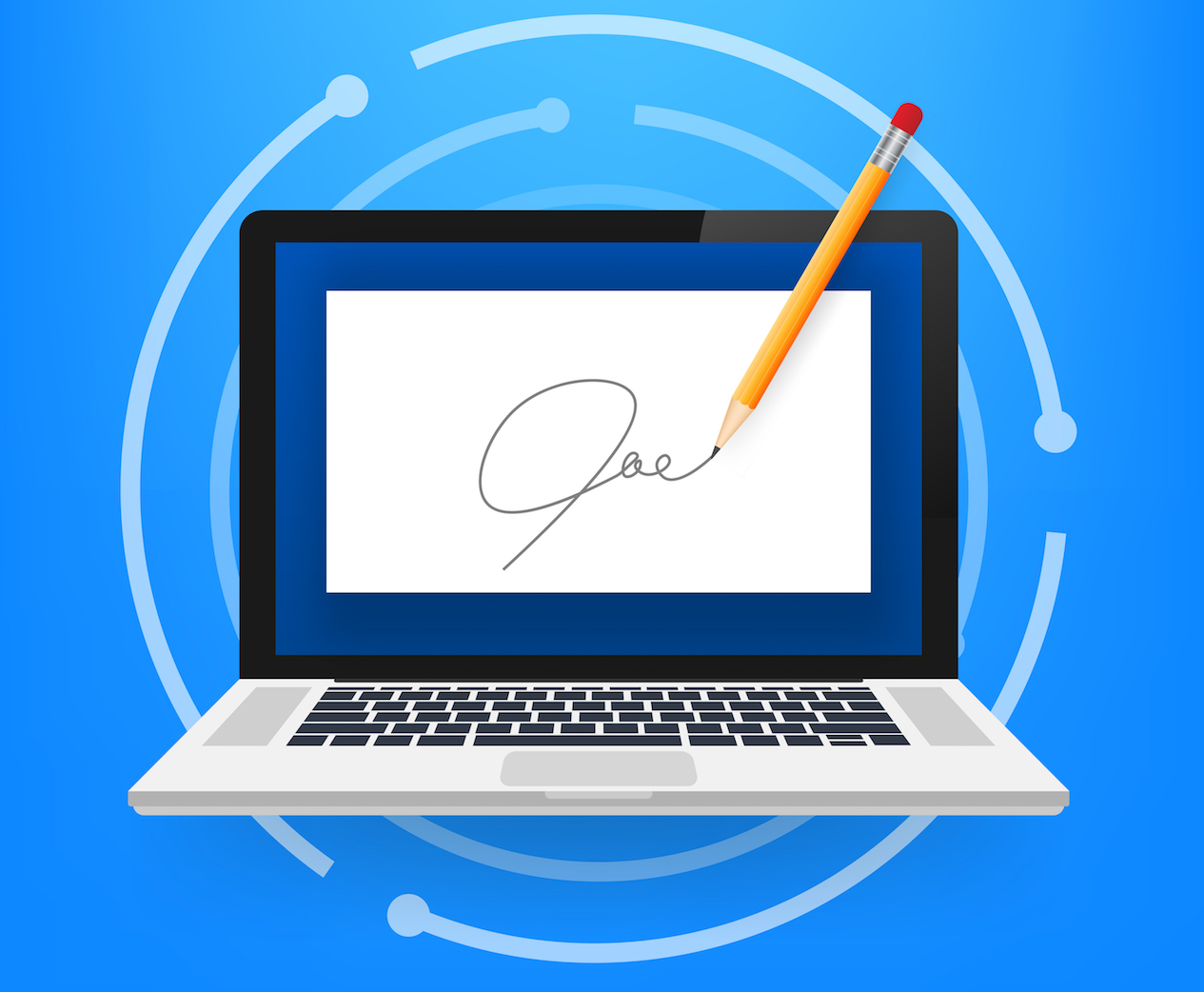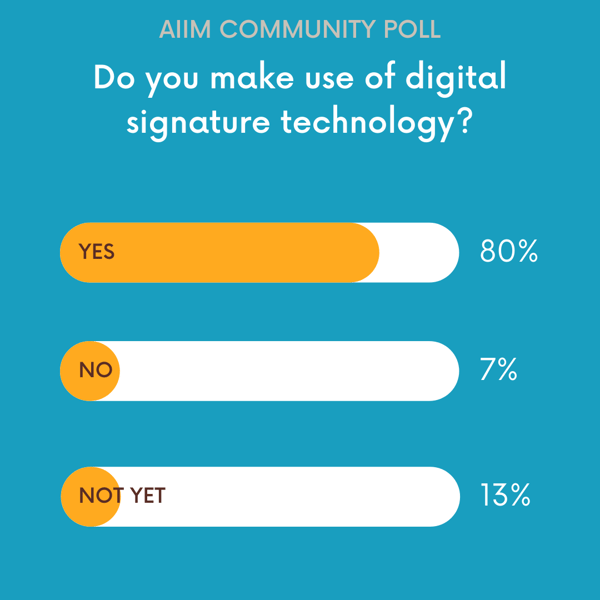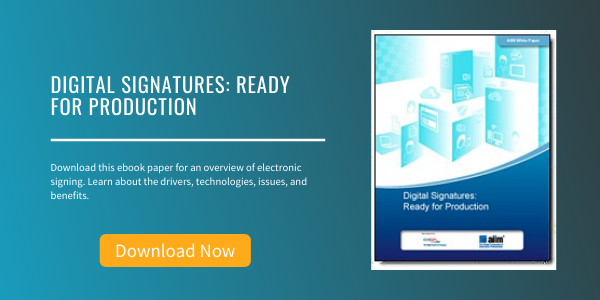
Digital Signatures 101 – Drivers, Barriers, and User Research
In a truly all-digital world, there would be no need for printers – or scanners or document couriers. Documents would never need to be printed, and processes would run smoothly from all-electronic input to all-electronic output.
This may already the reality for some leading companies, but for most organizations, forms, contracts, agreements, and signoffs are still rooted in wet ink on paper.
In this post, we’ll examine the importance of signatures for various organizations - particularly for process sign-offs and professional authorizations, look at the drivers for electronic signing, the issues that might be preventing adoption, and look at how the AIIM Community views digital signatures.
Sound good? Great, let’s dive right in!
What are Digital Signatures?
Digital Signatures typically use a representation of a signature image to identify the signer and are created in a proprietary format that can only be validated by the system that created them.
Digital signatures are based on Public Key Infrastructure (PKI) standards such that the authenticity and intent of the signer, as well as the integrity of the signed document, can be validated independently of the application that was used to sign it.
Simply put, Digital Signatures provide the same authority and approval of a physical signature but are just completed digitally.
It’s this simple distinction that unlocks the true power of Digital Signatures. Just think of how efficiency increases when the paper is removed!

Digital Signatures vs. Electronic Signatures vs. e-Signatures
Often called Electronic Signatures, Digital Signatures, or e-signatures - it’s likely you’ve come across these terms in some way. And if you’re like most, you’re probably wondering what the difference is. Aren’t these terms all the same thing?
Well, sort of…
Electronic and digital signatures are related: all digital signatures are also electronic signatures, but not the obverse: only some electronic signatures are digital signatures.
Outside of the US, the terms Advanced Electronic Signature and Qualified Electronic Signature are also commonly used in preference to “digital signature.”
The differences between electronic signatures and digital signatures are based on Public Key Infrastructures (PKI).
Generally speaking, Digital Signatures is the correct usage.
What are the Drivers for Digital Signatures?
Distributing documents electronically is not an issue these days, but collecting a physical signature is, and as we all get more connected, any delay in an authorization response becomes less and less acceptable.
Even small businesses will have authorized signers who formally sign documents two or more times a day. In larger organizations, the number rapidly grows to many hundreds of people, signing thousands of documents a day!
Let’s take a look at the main drivers for Digital Signatures:
-
Reduce Unnecessary Printing: Think of the time and costs involved with printing, posting, faxing, physically signing, and rescanning digitally created or digitally “born” documents. These actions add considerable costs, delays, and staff inefficiencies.
When you add it all up, it’s easy to see that the simple process of signing business documents includes many unnecessary handling costs and wastes considerable time, money, and resources.
- Reduce Interrupted Processes: When asked about the use of workflow and automated processes, 58% of AIIM survey respondents indicated that they are or would like to use workflow to automate signing tasks. When asked about the proportion of electronic or scanned document workflows that are interrupted, slowed down, or prematurely completed by the need to collect physical signatures, 37% of respondents indicated that half or more of their workflows are impacted.
-
Drivers for SharePoint: SharePoint is relatively straightforward to use for many workflow processes, including staff claims, purchase requisitions, and project reports, among many examples. The tick box that is generally used to indicate approval, while relying on the login password for authentication, does not support the need to apply an authorized signature. This process highlights the need for SharePoint users to have a more rigorous signature mechanism.
Caution is advised when creating or incorporating the more basic electronic signature solutions. In order to maintain legal and regulatory compliance, the solution must ensure that an auditable security regime is maintained, while ease-of-use and scaling issues must be key considerations when it comes to manual PKI solutions.

What are the Barriers or Challenges to Digital Signatures?
As with any great advancement in technology, Digital Signatures do come with their challenges. As we’ll discover, most of these barriers are more misconceptions of the technology and there are actually many more reasons to abandon paper signatures forever.
-
Legality Concerns: Industry sectors like Government, Healthcare, Pharmaceutical, and Banking and Finance all the rely heavily on signatures for their day-to-day activities. However, these industries are also highly regulated, and therefore, many have concerns over the legality of Digital Signatures.
Are digital signatures legal?
“The U.S. Electronic Signatures in Global and National Commerce (ESIGN) Act in 2000 legislated that electronic signatures are legal in every state and U.S. territory where federal law applies. Where federal law does not apply, most U.S. states have adopted the Uniform Electronic Transactions Act (UETA).” - U.S. Guide to Electronic Signatures.
- Cost Concerns: Whenever adopting new technology, cost is always a concern. Generally, there is an upfront investment required and a period before ROI is achieved. The good thing about Digital Signatures is they are designed for efficiency and cost savings. AIIM research shows 68% of existing digital signature users have seen a payback within one 12-month budget cycle.
- Lack of Familiarity: As evidenced by the misconceived “barriers,” Digital Signatures are still working to earn their seat that the table. Once thought of as futuristic, Digital Signatures are becoming an increased factor in our day-to-day. As more businesses that we interact with in our personal lives adopt Digital Signatures, trust and familiarity continue to rise.
The AIIM Community Weighs in on Digital Signatures
We asked the AIIM Community: Do you make use of digital signature technology?
With over 90 responses, here’s a look at what they said:

Among the global Intelligent Information Management community, the story seems to be clear - Digital Signatures are being used at the majority of organizations. After exploring the main drivers of this technology, it becomes clear as to why. If we dig into this data further we see that of the 20% currently NOT using Digital Signatures, more than half (13%) report "not yet" and likely plan to incorporate this technology into their strategy in the future. When doing so, always make sure to do your research before adopting new technology or selecting a solution.



